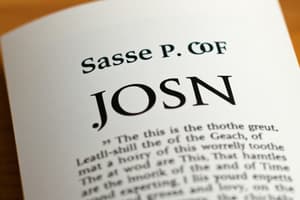Podcast
Questions and Answers
What does the miracle of turning water into wine signify in the context of John’s Gospel?
What does the miracle of turning water into wine signify in the context of John’s Gospel?
- Salvation is by the Word (correct)
- Salvation brings satisfaction
- Salvation is by faith
- Salvation is by grace
Which sign is associated with the concept that salvation brings peace?
Which sign is associated with the concept that salvation brings peace?
- Stilling the storm (correct)
- Raising of Lazarus
- Healing of the nobleman’s son
- Feeding the 5,000
In John's Gospel, which group consistently displayed unbelief in Jesus' signs?
In John's Gospel, which group consistently displayed unbelief in Jesus' signs?
- Nobleman’s family
- Jews (correct)
- Samaritans
- Disciples
What does the healing of the paralytic demonstrate in the structure of the signs in John’s Gospel?
What does the healing of the paralytic demonstrate in the structure of the signs in John’s Gospel?
Which sign serves as a basis for Jesus' sermon on the Bread of Life?
Which sign serves as a basis for Jesus' sermon on the Bread of Life?
What is the relationship between the miracles and the presentations of Jesus' deity in John's Gospel?
What is the relationship between the miracles and the presentations of Jesus' deity in John's Gospel?
What does the raising of Lazarus signify in relation to the results of salvation?
What does the raising of Lazarus signify in relation to the results of salvation?
What is the primary theme of the Gospel of John?
What is the primary theme of the Gospel of John?
Which of the following best describes John's approach compared to the Synoptic Gospels?
Which of the following best describes John's approach compared to the Synoptic Gospels?
What term does John use to describe the miracles performed by Jesus?
What term does John use to describe the miracles performed by Jesus?
Which I AM statement emphasizes Jesus as a provider of spiritual nourishment?
Which I AM statement emphasizes Jesus as a provider of spiritual nourishment?
Which of the following is NOT one of the key repeated words in John's Gospel?
Which of the following is NOT one of the key repeated words in John's Gospel?
Which Gospel presents Jesus as the King of the Jews?
Which Gospel presents Jesus as the King of the Jews?
What significant aspect does John emphasize in his Gospel?
What significant aspect does John emphasize in his Gospel?
How does John's writing style differ from that of the Synoptic Gospels?
How does John's writing style differ from that of the Synoptic Gospels?
Flashcards
John's Gospel Theme
John's Gospel Theme
Encourages belief in Jesus as Lord and receiving new life through Him.
Synoptic Gospels
Synoptic Gospels
Matthew, Mark, and Luke; similar perspectives on Jesus' life with unique emphases.
John's Gospel Signs
John's Gospel Signs
Seven miracles showing Jesus' divinity; carry spiritual messages.
Jesus' 'I AM' statements
Jesus' 'I AM' statements
Signup and view all the flashcards
Water into wine
Water into wine
Signup and view all the flashcards
Faith vs. Unbelief
Faith vs. Unbelief
Signup and view all the flashcards
Jesus' Ministry
Jesus' Ministry
Signup and view all the flashcards
Miracle of Healing Paralytic
Miracle of Healing Paralytic
Signup and view all the flashcards
Feeding of the 5000
Feeding of the 5000
Signup and view all the flashcards
Stilling the Storm
Stilling the Storm
Signup and view all the flashcards
Healing of the Blind Man
Healing of the Blind Man
Signup and view all the flashcards
Raising of Lazarus
Raising of Lazarus
Signup and view all the flashcards
Conflict with the Jews
Conflict with the Jews
Signup and view all the flashcards
'I AM' Statements
'I AM' Statements
Signup and view all the flashcards
Key Words in John
Key Words in John
Signup and view all the flashcards
Jesus' Kingly Role
Jesus' Kingly Role
Signup and view all the flashcards
Study Notes
The Theme of the Gospel
- John 20:30-31 focuses on Jesus Christ, the divine Son of God.
- John's Gospel explores the signs Christ performed during His ministry, confirming His deity.
- These signs were witnessed by trusted individuals, including the disciples and others.
- John's purpose is to encourage readers to believe in Jesus as Lord and receive new life through Him.
Comparison to the Other Gospels
- The Synoptic Gospels (Matthew, Mark, and Luke) share similar perspectives on Christ's life, each with a unique emphasis.
- Matthew portrays Christ as the King of the Jews, Mark presents Him as the Servant, and Luke sees Him as the Son of Man, emphasizing their intended audience.
- Unlike the Synoptic Gospels, John's Gospel goes deeper into the spiritual meaning behind events in Christ's life.
- It expands upon the miracles, revealing deeper truths not emphasized in the other Gospels.
- The feeding of the 5,000 is an example where John presents the sermon on the Bread of Life (John 6), explaining the miracle's significance.
- John uses "sign" instead of "miracle" to signify that these events carry spiritual messages.
Key Words in John's Gospel
- Repeated key words like life, believe, light and darkness, truth, witness, world, glory, receive, Father, come, eternal, and everlasting summarize the Gospel's message.
Christ in John's Gospel
- John emphasizes both the Person of Christ and His work.
- He records sermons where Christ speaks about Himself and clarifies His mission.
- Christ's seven "I AM" statements reveal His deity:
- I AM the Bread of life (6:35, 41, 48, 51)
- I AM the Light of the world (8:12; 9:5)
- I AM the Door of the sheep (10:7, 9)
- I AM the Good Shepherd (10:11, 14)
- I AM the Resurrection and the Life (11:25)
- I AM the way, the truth, and the life (14:6)
- I AM the true Vine (15:1, 5)
- These statements align with God's name "I AM" (Exodus 3:14) which highlights Christ's divine nature.
Signs in John's Gospel
- John selects seven specific miracles to prove Christ's deity (excluding the eighth in chapter 21, which was for the disciples).
- These signs have a specific order, forming a picture of salvation.
- The first three signs show how salvation reaches the sinner:
- Water into wine (2:1-11): Salvation comes through the Word.
- Healing the nobleman's son (4:46-54): Salvation is received through faith.
- Healing the paralytic (5:1-9): Salvation is given by grace.
- The last four signs demonstrate the results of salvation in the believer:
- Feeding the 5,000 (6:1-14): Salvation brings satisfaction.
- Stilling the storm (6:16-21): Salvation brings peace.
- Healing the blind man (9:1-7): Salvation brings light.
- Raising of Lazarus (11:38-45): Salvation brings life.
- Each miracle reveals Christ's divinity (5:20, 36), serving as opportunities for His teachings and interactions.
- Nicodemus' visit to Christ (3:2) was motivated by the signs He witnessed.
- The healing of the paralytic (5:1-9) led to the discourse in 5:10-47.
- The feeding of the 5,000 was the basis for the sermon on the Bread of Life in chapter 6.
- The excommunication of the healed blind man (9:34) led to the sermon on the Good Shepherd who never rejects anyone (chapter 10).
Faith and Unbelief in John's Gospel
- One central theme of John's Gospel is the opposition between faith and unbelief.
- The Gospel begins with the rejection of Jesus by Israel (1:11), culminating in His crucifixion.
- Many Jews throughout the book resist the evidence for his divinity, growing increasingly hardened in their rejection.
- In contrast, a smaller group, including the disciples, a nobleman and his family, Samaritans, a paralytic, a blind man, and others, choose to believe in Jesus.
- This conflict mirrors the situation today, where the world largely rejects Christ, while some individuals accept Him based on evidence.
- The Jews' controversy with Christ intensifies after the miracle in chapter 5, particularly because of the healing on the Sabbath.
- Chapters 7-12 see the conflict escalate, with attempted arrests and even attempts to stone Christ.
- The climax comes in chapters 18-19 with His arrest and crucifixion.
- Three significant crisis events mark the Gospel:
- 6:66-71: The multitudes leave Christ despite wanting to make Him king.
- 12:12-50: People refuse to believe in Him, despite recognizing Him as King.
- 19:13-22: They crucify Him after proclaiming "We have no king but Caesar."
- Christ is the way, the truth, and the life, but they reject Him.
Christ's Ministry
The Year of Opening (Marks the Official Beginning of Jesus' Ministry)
- Ministry of John the Baptist (1:1-8, 3:1-12, 3:18)
- Baptism of Jesus (1:9-11, 3:13-17, 3:21-22, Colossians 2:12)
- Temptation of Jesus (1:12-13, 4:1-11, 4:1-13)
- Testimony of John the Baptist (1:19-36)
- Five disciples called (1:35-49)
- Changes water into wine, the first miracle (2:1-11)
- First Passover (2:13-17)
- Temple cleansed (2:13-17)
- Discourse on the new birth (3:1-18)
The Year of Ovation (A Show of Appreciation From an Audience)
- Rejected at Nazareth (4:28-30, Isaiah 53:3)
- Withdraws to Capernaum (4:13-16, 4:31-32)
- Four disciples called (4:18-22, 1:16-20, 5:8-11)
- Miraculous catch of fish (5:4-9)
- Demon-possessed man healed (1:23-28, 4:33-37)
- Peter's mother-in-law healed (8:14-15, 1:29-31, 4:38-39)
- Later Galilean Ministry (4:23-25, 1:38-39, 4:43-44)
- Leper cleansed (8:2-4, 1:40-42, 5:12-13)
- Returns to Capernaum (2:1-2)
- Paralytic healed (9:2-8, 2:2-12, 5:18-26)
- Matthew called (9:9, 2:13-14, 5:27-28)
- Second Passover (5:1)
- Man at the pool healed (5:2-9)
- Discourse on Jesus' divinity (5:17-47)
- Discourse on the Sabbath (5:17-47)
The Year of Opposition (To Be Against Something Or To Have A Conflicting Stance)
- Rejected at Nazareth again (13:54-58, 6:1-6)
- Disciples sent out (10:5-42, 6:7-13, 9:1-6)
- The Third Tour of Galilee (9:35-38, 6:6)
- John the Baptist dies (14:1-2, 6-12, 6:14-16, 21-29, 9:7-9)
- Vacation interrupted (14:13-14, 6:30-34, 9:10-11, 6:1-4)
- Five thousand fed (14:15-21, 6:35-44, 9:12-17, 6:5-14)
- Jesus walks on the sea (14:22-33, 6:45-52, 6:16-21)
- Many miracles performed (14:34-36, 6:53-56)
- Discourse on the bread of life (6:25-59)
- Falling away of some disciples (6:60-71)
- Pharisees rebuked (6:60-71)
Studying That Suits You
Use AI to generate personalized quizzes and flashcards to suit your learning preferences.
Description
Explore the distinct themes of the Gospel of John, particularly its focus on Jesus Christ as the divine Son of God. Discover how it compares to the Synoptic Gospels and highlights deeper spiritual meanings behind Christ's miracles, such as the feeding of the 5,000.





